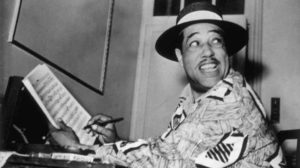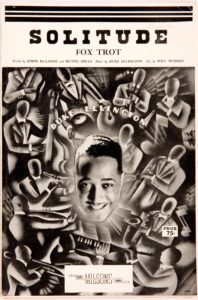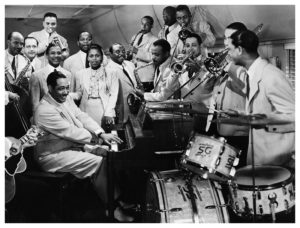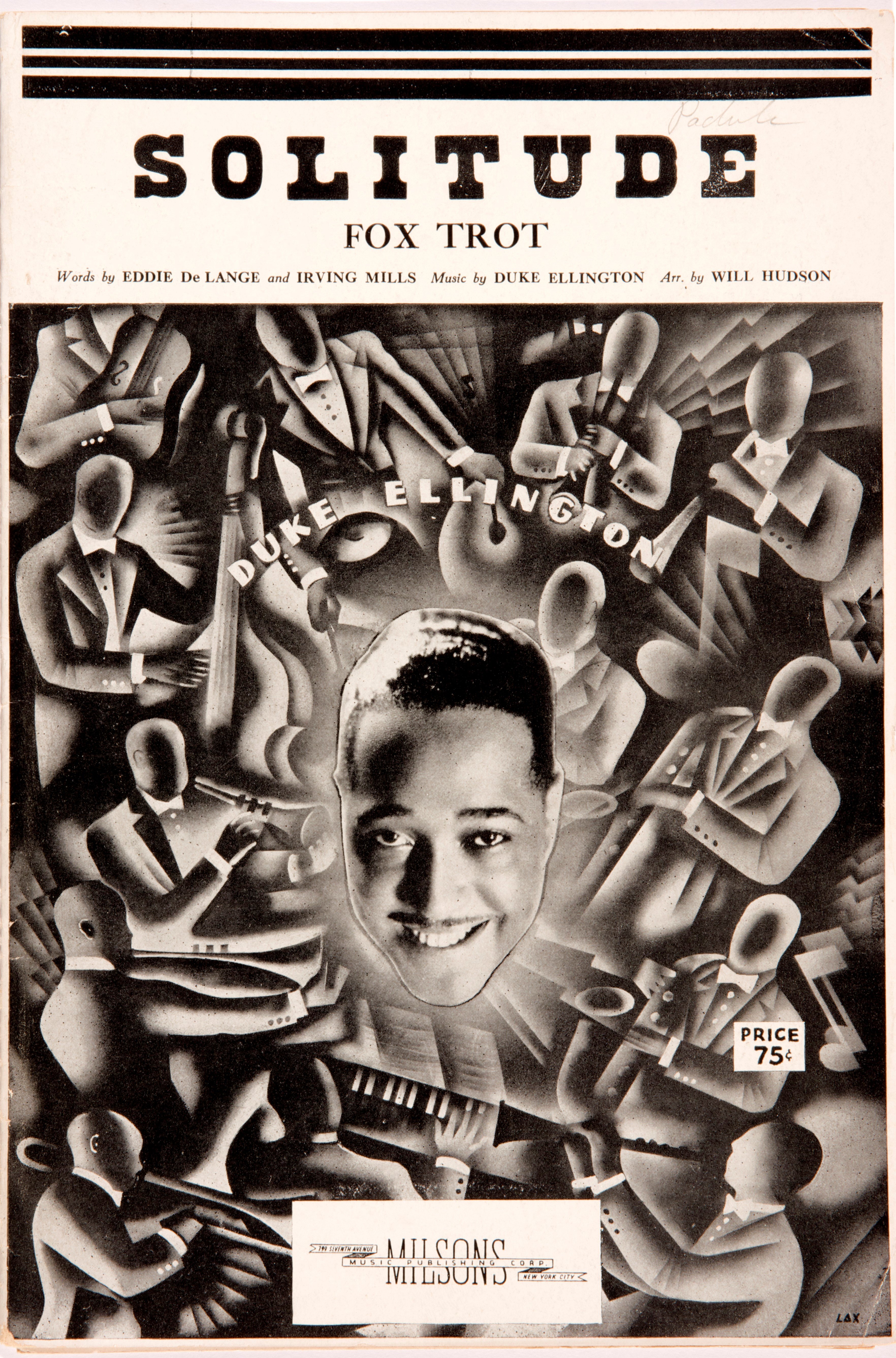“’Solitude’ I wrote in 20 minutes in Chicago standing up against the glass office enclosure waiting for another band to finish recording.”
Duke Ellington’s comment is hard for the musician in me to swallow, because the musical score, with its complex chording and swinging rhythms, sure doesn’t sound like its composition took place in the time frame that I can eat a Chipotle burrito. Luckily, I’ve long since accepted that some people have more talent in their piano-playing-pinkie finger than I have in my entire body (but maybe I could beat him in a Chipotle eating contest).

Duke Ellington composing. His career spanned for over fifty years, and he produced over 1000 lasting works. Keystone/Getty Images.
Edward Kennedy “Duke” Ellington (1899-1974) was involved in music from the age of seven, and in 1923 he moved to New York and began his road to fame with his jazz orchestra “The Washingtonians.” He recruited several great jazz musicians of the time, including James “Bubber” Miley, “Trick Sam” Nanton, Harry Carney and Johnny Hodge. Ellington then wrote music that matched each musician’s unique style, layering and blending the instruments’ textures.

heet music cover. Solitude. Arranged by Eddie Powell. Words by Eddie De Lange and Irving Mills. Music by Duke Ellington. Milsons Music Publishing Corp., New york City, New York. 1934.
From 1927-1930 Duke Ellington led the house band at the Cotton Club, a prominent venue in central Harlem. He played there sporadically for the following eight years, and used their weekly radio broadcasts to expand his reputation and audience nation-wide. The band toured in England and Scotland in 1933 and 1934, where they accrued a large international following. In 1934, Ellington wrote the jazz standard “Solitude,” which he recorded and performed on a multitude of occasions in the late 1930s and beyond.
The sheet music cover of “Solitude” is part of The Cooper Hewitt Library collection, and is currently featured in Cooper Hewitt, Smithsonian Design Museum’s exhibition, Esperanza Spalding Selects. Ellington’s face is front and center, smiling at the audience while his jazz orchestra is shown as faceless men in suits, playing a range of instruments. The construction of the cover reflects Ellington’s leadership role in the orchestra—he directed the style and sound of the orchestra by composing music specifically tailored for his musicians’ talents.
Right before Ellington wrote “Solitude,” the Great Depression hit jazz music hard. The recording industry dropped over 90% of its artists by 1933, and Ellington was among the few great bandleaders able to find consistent employment. Popular musical styles changed in the light of the Great Depression; in the early 1930s songwriters wrote music that identified with the hardships of the time[1]. But in 1935, as the crisis of the Great Depression began to lift under Franklin D. Roosevelt’s presidency, big band music became the most popular musical style in the United States. Labeled the “Swing Era,” the music’s upbeat and jazzy sound seemed to usher in positivity and energy along with the newfound hope of the time.

Publicity still of Duke Ellington with his band in 1943. Photo Credit: John D. Kisch. Getty Images.
Ellington’s song “Solitude” is remarkable because it seems to simultaneously reflect the energy of the Swing Era alongside the feelings of struggle and suffering that resounded during the Great Depression. The piece has complex rhythms and Ellington’s big band sound—as the cover states, the piece is meant for the ‘foxtrot,’ an energetic and lively dance. However, the song also has a slower cadence and lyrics that begin, “In my solitude/ You haunt me/ With dreadful ease/ Of days gone by.” The almost melancholic feeling of the song can be seen as a wish to return to a time past, or at least as a recognition of the many hardships of the 1930s. Through one song, Ellington encapsulates the transition period of the public’s mood. “Solitude” provides a musical escape from hardship through dance, but simultaneously recognizes and identifies with the common struggles and misfortunes of the time.
Written by Jessica Masinter. She is an intern in Smithsonian Design Library at Cooper Hewitt and a literary studies major at Middlebury College.
[1] Sanders, Sam. “Remembering The Great Depression’s Sunny Side.” NPR. NPR, 23 Oct. 2009. Web. 15 June 2017.

One thought on “The Solitude of Swing”
Michael Leddy on June 25, 2017 at 10:14 am
I’m happy to see this sheet music cover, but I care too much about Duke Ellington’s music not to say a few things:
Names: Joe “Tricky Sam” Nanton, not “Trick Sam.” Johnny Hodges. Not “Hodge.”
Harry Carney was not known as one of the “great jazz musicians of the time” when Ellington brought him on board. Carney was just seventeen. He made his reputation as a great baritone saxophonist (many would say the greatest) in his decades with Ellington.
It’s impossible to imagine “Solitude” as music for “an energetic and lively dance” or as music that reflects “the energy of the Swing Era.” It’s introspective and melancholy. Just listen.